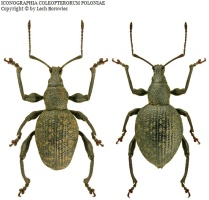
Русские, остановите эту войну! Спасите Свободную Украину!
Russians, stop this war! Save Free Ukraine!
Biodiversity Map
Taxa

-
Arthropodaphylum
Click to switch
to select orders
and filters > -
Hexapodasubphylum
Click to switch
to select orders
and filters > -
Insectaclass
Click to switch
to select orders
and filters > -
Coleopteraorder
Click to set
as the main taxon
and as a base
← of the left panel > -
Polyphagasuborder
Click to set
as the main taxon
and as a base
← of the left panel > -
Cucujiformiaseries
Click to set
as the main taxon
and as a base
← of the left panel > -
Curculionoideasuperfamily
Click to set
as the main taxon
and as a base
← of the left panel > -
Curculionidaefamily
Click to set
as the main taxon
and as a base
← of the left panel > -
Entiminaesubfamily
Click to set
as the main taxon
and as a base
← of the left panel > -
Otiorhynchinitribe
Click to set
as the main taxon
and as a base
← of the left panel > -
Dodecastichusgenus
Click to set
as the main taxon
and as a base
← of the left panel >
species:
Dodecastichus mastix
PL
YES
name status: valid name
BioMap ID: 1046535
taxon code: 4988
taxonomy checked: YES
Polish Red List: EX?
Data on distribution in Poland

Statistics
- Records: 26
- Publications: 17
- Collections: 3
- Publication authors: 16
- Illustrations (iconography): 1
- Photos (specimen/observation): lacking
Taxon description
Gatunek górski, rozsiedlony głównie na Półwyspie Bałkańskim, w Karpatach, południowo-wschodnich Alpach i Apeninach. W Polsce chrząszcz mało znany. Niedawno został wykazany z jednego tylko stanowiska w Kotlinie Nowotarskiej. Wzmianki sprzed przeszło 130 lat o występowaniu tego gatunku w Beskidzie Wschodnim nie znalazły później potwierdzenia, a o zasiedleniu Śląska wątpił J. Gerhardt (1891e). Bionomia tego gatunku i jego cykl rozwojowy nie są znane. Postacie dojrzałe poławiano na różnych krzewach.
Illustrations
... browse
 Dodecastichus
Dodecastichusmastix
External data sources
- Ostatnie rekordy
-
1003937
 ×
× Curculionidae: Dodecastichus mastix, coll. MiIZ PAN: Tenenbaum Sz.
Curculionidae: Dodecastichus mastix, coll. MiIZ PAN: Tenenbaum Sz. -
1003936
 ×
× Curculionidae: Dodecastichus mastix, coll. MiIZ PAN: Tenenbaum Sz.
Curculionidae: Dodecastichus mastix, coll. MiIZ PAN: Tenenbaum Sz. -
1003935
 ×
× Curculionidae: Dodecastichus mastix, Austria, coll. MiIZ PAN: Tenenbaum Sz.
Curculionidae: Dodecastichus mastix, Austria, coll. MiIZ PAN: Tenenbaum Sz. -
940913
 ×
× Curculionidae: Dodecastichus mastix, SK, Tatry Bielskie, Jahnacia dolina, UTM , 1882, coll. Hungarian Natural History Museum, Budapest (Knutelski 2005)
Curculionidae: Dodecastichus mastix, SK, Tatry Bielskie, Jahnacia dolina, UTM , 1882, coll. Hungarian Natural History Museum, Budapest (Knutelski 2005) -
806613
 ×
× Curculionidae: Dodecastichus mastix, PL, "Karpaty" (Knutelski 2000)
Curculionidae: Dodecastichus mastix, PL, "Karpaty" (Knutelski 2000) -
806612
 ×
× Curculionidae: Dodecastichus mastix, PL, "Śląsk" (Knutelski 2000)
Curculionidae: Dodecastichus mastix, PL, "Śląsk" (Knutelski 2000) -
806611
 ×
× Curculionidae: Dodecastichus mastix, PL, "Polska" (Knutelski 2000)
Curculionidae: Dodecastichus mastix, PL, "Polska" (Knutelski 2000) -
806610
 ○
○ Curculionidae: Dodecastichus mastix, PL, Beskid Wschodni, UTM EA60 (Knutelski 2000)
Curculionidae: Dodecastichus mastix, PL, Beskid Wschodni, UTM EA60 (Knutelski 2000) -
806609
 ○
○ Curculionidae: Dodecastichus mastix, PL, Kotlina Nowotarska, UTM DV27 (Knutelski 2000)
Curculionidae: Dodecastichus mastix, PL, Kotlina Nowotarska, UTM DV27 (Knutelski 2000) -
806608
 ○
○ Curculionidae: Dodecastichus mastix, PL, Dolny Śląsk, UTM XS24 (Knutelski 2000)
Curculionidae: Dodecastichus mastix, PL, Dolny Śląsk, UTM XS24 (Knutelski 2000) - ... more
- Powiązane publikacje
-
Knutelski S. 2005. Różnorodność, ekologia i chorologia ryjkowców rezerwatu biosfery "Tatry" (Coleoptera: Curculionoidea). Monografie Faunistyczne, 23, Wydawnictwa ISEZ PAN, Kraków.
 Show records
Show records -
Knutelski S. 2000. Uwagi o ryjkowcach (Coleoptera, Curculionoidea) Kotliny Nowotarskiej. Chr. Przyr. Ojcz., 56(2):51-67.
 Show records
Show records -
Burakowski B., Mroczkowski M., Stefańska J. 1993. Chrząszcze – Coleoptera. Ryjkowce – Curculionidae, część 1. Katalog Fauny Polski, XXIII, 19, Warszawa.
 Show records
Show records -
Mroczkowski M., Stefańska J. 1991. Coleoptera – Chrząszcze. [In:] Razowski J. (Ed.) Wykaz Zwierząt Polski. Tom III, Część XXXII/22, 23, Insecta: Coleoptera, Strepsiptera. Krakowskie Wydawnictwo Zoologiczne. pp. 7-197.
 Show records
Show records -
Kuśka A. 1985b. Otiorhynchus obsoletus Stierl. i O. rugifrons (Gyll.) – nowe dla fauny Polski ryjkowce (Coleoptera, Curculionidae) i uwagi o innych gatunkach tego rodzaju. Pol. Pismo Ent., 55:601-604.
 Show records
Show records - ... more
- Powiązane zbiory
-
ISEZ PAN
 Show records
Show records -
MiIZ PAN: Tenenbaum Sz.
 Show records
Show records -
Hungarian Natural History Museum, Budapest
 Show records
Show records
- Wykaz powiązanych pozycji
-
Weevils of the Tatra Mts.
 Show records
Show records




